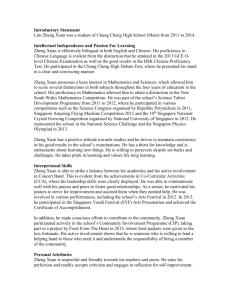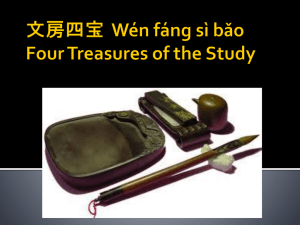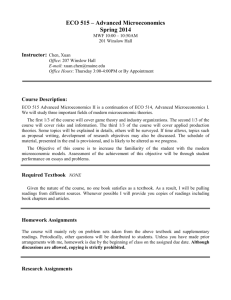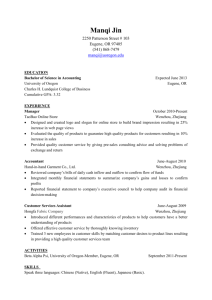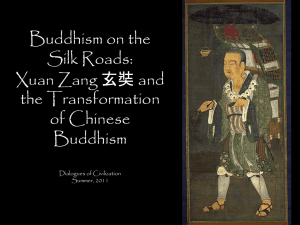res_3_03_135_144.doc
advertisement
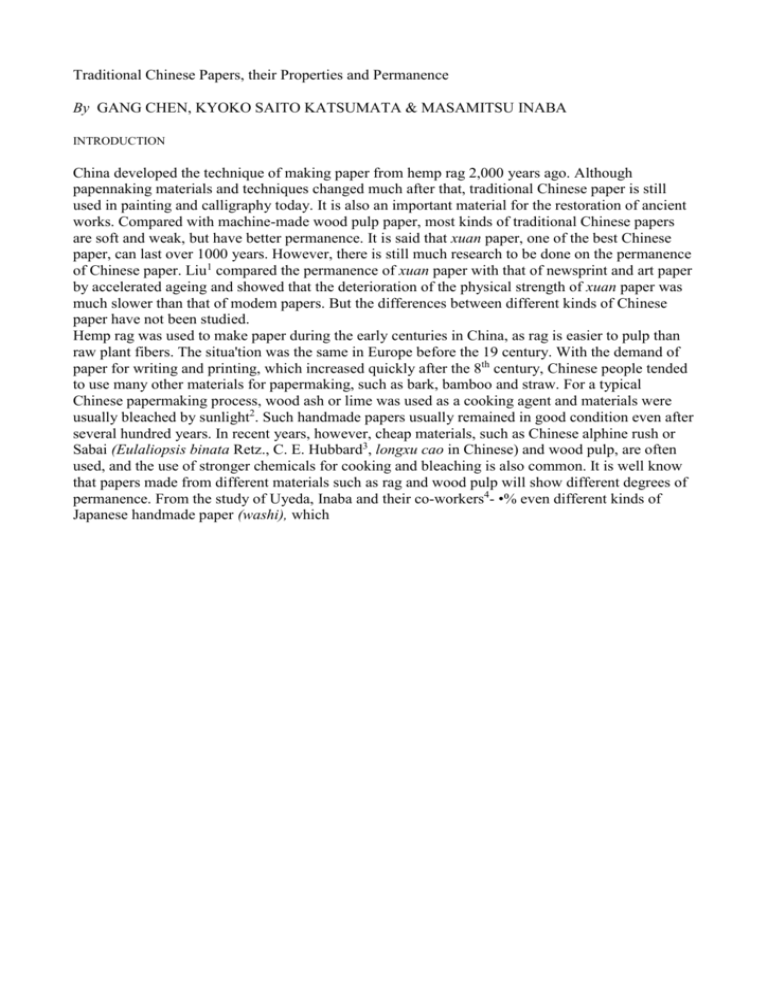
Traditional Chinese Papers, their Properties and Permanence By GANG CHEN, KYOKO SAITO KATSUMATA & MASAMITSU INABA INTRODUCTION China developed the technique of making paper from hemp rag 2,000 years ago. Although papennaking materials and techniques changed much after that, traditional Chinese paper is still used in painting and calligraphy today. It is also an important material for the restoration of ancient works. Compared with machine-made wood pulp paper, most kinds of traditional Chinese papers are soft and weak, but have better permanence. It is said that xuan paper, one of the best Chinese paper, can last over 1000 years. However, there is still much research to be done on the permanence of Chinese paper. Liu1 compared the permanence of xuan paper with that of newsprint and art paper by accelerated ageing and showed that the deterioration of the physical strength of xuan paper was much slower than that of modem papers. But the differences between different kinds of Chinese paper have not been studied. Hemp rag was used to make paper during the early centuries in China, as rag is easier to pulp than raw plant fibers. The situa'tion was the same in Europe before the 19 century. With the demand of paper for writing and printing, which increased quickly after the 8th century, Chinese people tended to use many other materials for papermaking, such as bark, bamboo and straw. For a typical Chinese papermaking process, wood ash or lime was used as a cooking agent and materials were usually bleached by sunlight2. Such handmade papers usually remained in good condition even after several hundred years. In recent years, however, cheap materials, such as Chinese alphine rush or Sabai (Eulaliopsis binata Retz., C. E. Hubbard3, longxu cao in Chinese) and wood pulp, are often used, and the use of stronger chemicals for cooking and bleaching is also common. It is well know that papers made from different materials such as rag and wood pulp will show different degrees of permanence. From the study of Uyeda, Inaba and their co-workers4- •% even different kinds of Japanese handmade paper (washi), which are made from the same material, kozp (paper mulberry), will have different levels of permanence if cooked using different agents. It is likely therefore that changes in the materials and paper-making processes may also harm the permanence of Chinese paper. In our research, seven kinds of traditional Chinese paper for painting and calligraphy were selected as samples to investigate their strength and durability after accelerated ageing. The effect of jiaofanshui (animal glue with alum, dosa in Japanese), which is often used in Chinese and Japanese painting as an acidic sizing agent, was also studied. Results of the change in physical strength during accelerated ageing were reported at Bunkazai Hozon-syuhuku Gakkaisi (in Japanese)6. In this article, the composition and degree of polymerization of these papers will be discussed. EXPERIMENT Materials and treatment • Three types of xuan paper made from rice straw and wingceltis bark*, with different ratios of the two materials in each. • Mianliao, 30% wingceltis bark and 70% rice straw, • Jingpi, 60% wingceltis bark and 40% rice straw, • Tejingpi, 70% wingceltis bark and 30% rice straw. Xuan paper is said to be the best paper for Chinese painting and calligraphy because it can fully display the special qualities of Chinese ink. • Shuxuan, a kind of sized xuan paper, whose main constituent is Chinese al-phine rush (Eulaliopsis binatd). • Daqian writing paper, which is said to be bamboo paper but which appeared from our analysis to be made from rice straw and wood pulp. It is usually used for practice painting and calligraphy because of its low price. • Fuyangxuan paper, made from Chinese alphine rush and wood pulp. As it is similar to xuan paper from its appearance, it is used as a substitute. It is also used for making facsimiles of antique books. • Wenzhou bast paper, a kind of machine-made paper made from mulberry bark. Pteroceltis tatarinowii, Maxim, also is called qingtanpiin China. Not to be found in the common fibre atlases. Schroeter, A.I. & V.A. Panasiak, Dictionary of Plant Names, ed, V.A. Bykov, Konigstein: Koeltz 1999, p. 621 no. 7441 give wing hackberry as the English equivalent. Table 1: The basic properties of test samples. All are commercially available and their basic properties are shown in Table 1. The samples were sized by jiaofanshui at two concentrations: low (0.7wt% animal glue and 0.35wt°/o alum); high (2wt°/o animal glue and lwt°/oalum. All samples were aged at 80°C and 65°/oRH for up to 16 weeks. Measurement Ash content was measured according to ISO 1762-1974 and spectrometrically analyzed using EDXRF SPECTRACE-6000*. The amount of alditol acetates of neutral sugars were measured using gas chromatography'. The samples (15mg) were dissolved in 72°/o(w/w) sulphuric acid (250μl) for 45 min at room temperature. The acid was then diluted with water (6.94ml) and hydrolyzed for 1 hour at 121°. After reducing the mono-saccharides by sodium borohydride for 90 min at 40°, the samples were acety-lated by 1-methyl imidazole and acetic anhydride. The alditol acetates were separated on a column (DB17; J & W Scientific) fitted to a Shimadzu GC-14A gas chromatograph. A viscosity mediod (solvent: cupriethylenediarnine: CuED) was used to measure die degree of polymerisation (DP) of the cellulose. To evaluate the degree of oxidation, the oxidation index of cellulose was calculated by comparing the DP of die cellulose of the reduced and unreduced samples8. Reduced samples were prepared by immersing papers in tertbutylamineborane(CH3)3CNH2BH3 0.2mol/l for Ihour and then dissolving them in CuED solution. Unreduced Spectrace Instruments, Inc.; tube voltage:15kV; current: O.lmA; filter: cellulose; atmosphere: vacuum. Fig. 1: Relation between amount of alum erated ageing. ■ Xuan paper (mianliao) X Daqian writing paper o Shuxuan Fig. 2: TEA retention after 16 weeks accel-and pH. ▲ Xuan paper (tejingpi) /X Fuyangxuan paper ♦ Xuan paper (jingpi) + Wenzhou bast paper samples were prepared by dissolving them in CuED solution first and heating for 1 hour at 60°. Oxidation index: k(l/DPunreduced- l/DPreduced), where k= 1234mmol/ lOOg. RESULTS AND DISCUSSION Previous results For unsized samples, xuan paper and daqian writing paper showed higher pH than fuyangxuan paper and wenzhou bast paper (Fig.l). After jiaofajishui-sizing, xuan paper maintained its high pH while fuyangxuan paper and wenzhou bast paper became more acidic (pH near to 4). Xuan paper showed a high buffer capacity towards the acidic sizing agent. It is well known that low pH will accelerate the hydrolysis of polysaccharides in paper and contribute to the deterioration of its physical strength. Most paper samples showed low physical strength, except for wenzhou bast paper (Table 2). After jiaofanshui-sizing, their tensile strength and folding endurance increased, while the tear index decreased because of the concentration of stress. Samples sized with jiaofanshui, however, easily lost their strength after accelerated ageing. To demonstrate this, retention of TEA (tensile energy absorption) after Table 2: Physical strength of unaged samples. * Load of the samples: wenzjwu bast: 4.9N; jingpi and tejingpi: 2.45N; mianliao, shuxuan, daqian writing andfoyangxuan:l.96N " Sized with a high concentration of jiaofanshui. 16 weeks was calculated. Among the unsized samples, xuan papers suffered less deterioration than other kinds of paper. Particularly manliao, which contained more rice straw than the other samples of xuan paper, and showed the greatest TEA retention. Rice straw is cooked using soda ash (sodium carbonate) and bleached by several months' exposure to sunlight. Traditionally, the other material, wingceltis bark, was bleached by the same method, but now it is bleached by sodium hypochlorite for just several hours. The difference in the pulping process may also contribute to the deterioration in strength. After being sized by jiaofanshui, all papers deteriorated more quickly than the samples which remained unsized because their pH was lowered. Fuyangxuan paper and wenzhou bast paper in particular had a very high deterioration rate, the samples became very brittle and yellow during accelerated ageing. The relationship between pH and the deterioration of the papers is shown in Fig. 2. Samples with a higher pH have a higher TEA retention. The results of folding endurance, tear strength and discoloration testing showed the same tendency. Ash content and neutral sugar composition Ash content* measurement and elemental analysis indicated that xuan paper and daqian writing paper contained a relatively high amount of ash, which consisted of mainly Ca and Si (Table 3). It is not surprising that these two kinds of paper The samples were incinerated at 525°. Table 3: Ash content and composition (%). Table 4: The composition (%) of neutral sugars in paper samples. contain Si as this element is present in rice straw, which is the main material of xuan paper and daqian writing paper; rice straw usually has a high Si content9. In the pulping process, lime may be used as a pre-cooking agent for rice straw. Residues of this mildly alkaline substance improve the buffering capacity of paper against acid. Daqian writing paper has a particularly high ash content. As the ash content of rice straw is about 10-18% while that of wood pulp is less than 3°/o9'10, the use of a filler may be considered. Meanwhile, fuyangxuan paper and wenzhou bast paper showed a low ash content and a low pH (4.0-4.8) after having been sized with jiaofanshui. The rate of deterioration for these two kinds of sized paper was very high. The amount of glucose, which originated mainly from cellulose, was relatively high in fuyangxuan paper and wenzhou bast paper, compared with that of xuan paper and daqian writing paper (Table 4). Of course, the materials of these kinds of paper are different; bast usually has a higher cellulose content than straw and grass. Nevertheless, the result still indicated that fuyangxuan paper and wemjiou bast paper probably were cooked using stronger agents. Most of the hemicellulose and other inorganic materials had been extracted and the amount of remaining cellulose was therefore relatively high. However, the process also caused more damage to the fibre; so it may be said that the permanence of these two kinds of paper will not be good in spite of their high cellulose content. The presence of mannose in fuyangxuan paper and daqian writing paper can be explained by the use of wood pulp in these papers; softwood usually contains more mannose in hemicellulose11. Degree of polymerization and oxidation index The DP of xuan paper is about 800. After accelerated ageing for 16 weeks, it decreased to 600. On the other hand, the DP of fuyangxuan paper and wenzjiou bast paper decreased from 750 to 300 (Fig.3). As the pH of the latter two is about 6.0, acidic hydrolysis seems to be one of the causes of the decline in DP. In the case of a jiaofanshui-sized sample, the DP of fuyangxuan paper and wenzfiou bast paper were less than 200 after accelerated ageing, while that of xuan paper was 370490. It is clear that pH plays an important role in the degradation of cellulose. As for the oxidation index of cellulose, fuyangxuan paper showed a relatively high value (Fig.4). This is considered to be the result of bleaching using an oxidizing agent. The oxidation of cellulose also accelerates the degradation of cellulose and discoloration of paper8. At the same time, the oxidation index of wenzhou bast paper was not so high, while its strength and DP decreased during accelerated ageing as rapidly as those of fuyangxuan paper. Considering its low pH, acidic hydrolysis should be considered as being the main reason for its deterioration. CONCLUSION By measuring the physical strength of paper samples and calculating their deterioration during accelerated ageing it became clear that the xuan paper and daqian writing paper had better permanence than the fuyangxuan paper and wenzhou bast paper. Fuyangxuan paper and wenzhou bast paper, which are submitted to nearly the same pulping and bleaching processes as modern paper made from chemical pulp, have similar properties: low pH, low ash content and high cellulose content but have more susceptibility to depolymerization after ageing. On the other hand, xuan paper and daqian writing paper, which are produced still using some of the original cooking and bleaching methods, have a higher ash content, higher pH and buffering capacity towards an acidic sizing agent. Considering the papermaking materials, mulberry bark usually results in better paper permanence than rice straw. However, the main conclusion we can draw from our tests is that, to obtain permanent durable paper, the production method is as important as the raw materials. ACKNOWLEDGEMENTS We wish to express our thanks to the Paper Science Laboratory of the University of Tokyo, and the Laboratory of Recycled Resource Science of Tokyo University of Agriculture and Technology for allowing the use of their paper testing equipment. SUMMARIES Traditional Chinese Papers, their Properties and Permanence Seven kinds of traditional Chinese paper made recently, i.e. three types of xuan paper, daqian writing paper, fuyangxuan paper and wenzhou bast paper, were selected to investigate their strength and durability after accelerated ageing. The effect of jiaofanshui (animal glue with alum) as an acidic sizing agent was also studied. Xuan paper and daqian writing paper have higher pH values, and a relatively high ash content, which consisted of mainly Ca and Si. The deterioration rate of their strength was lower. Xuan paper that is made using some of the traditional methods showed high buffering capacity towards the acidic sizing agent. Fuyangxuan paper and wenzhou bast paper, which were cooked and bleached using chemical agents in the same way as chemical wood pulp, had a higher cellulose content, but their DP decreased very fast during ageing. Therefore the deterioration rate of their strength was high. Fuyangxuan paper also had a relatively high degree of oxidation. Papiers traditionnels chinois, leurs proprietes et leur durabilite Sept sortes de papier traditionnel chinois, c'est-a-dire trois sortes de papier xuan, du papier a ecrire daqian, du papier fuyangxuan et du papier raphia wenzhou ont ete selectionnes et soumis a des tests de resistance et de durabilite apres traitement au vieillisement accelere. A ete egalement etudie 1'effet du jiaofanshui (colle animale avec addition d'alun) comme agent d'encollage acide. Le papier xuan et le papier a ecrire daqian ont un pH plus eleve et une teneur en cendres re-lativement forte qui se compose principalement de calcium et de silicium. Le degre de deterioration de leur resistance etait plus faible. Le papier xuan qui est fabrique selon certaines methodes traditionnelles fait preuve d'une plus grande capacite a resister contre 1'encollage acide. Le papier fuyangxuan et le papier raphia wenzhou, qui ont ete cuits et blanchis a Faide d'agents chimi-ques tels que ceux utilises lors de la fabrication de la cellulose a pate de bois, manifestaient une plus grande teneur en cellulose mais leur degre de polymerisation diminuait tres rapidement au cours du vieillissement. Ce qui entrainait une forte deterioration de leur resistance. Le papier fuyangxuan presentait egalement un degre d'oxydation relau'vement eleve. TraditioneUes chinesisch.es Papier: seine Eigenschaften und seine Dauerhaftigkeit Sieben Arten von tradiu'onellem chinesischem Papier, namlich drei Arten von Xuan Papier, so-dann flaji'an-Schreibpapier, Fuyangxuan Papier und Wenzjiou Bastpapier, wurden auf Festigkeit und Dauerhaftigkeit nach beschleunigter Alterung hin untersucht. Einbezogen wurde auch die Wirkung der sauren Leimung mil Jiaofanshui (tierischer Leim mit Zusatz von Alaun). Xuan und .Dagi'anSchreibpapier haben ein hoheres pH und einen relativ hohen Aschegehalt, der iiber-wiegend aus Calcium- imd Siliciumverbindungen besteht. Sie verloren ihre Festigkeit weniger stark. Xuan wird in bestimmtem AusmaB nach traditionellen Methoden hergestellt; es zeigt eine hohere Pufferkapacitat gegeniiber saurer Leimung. Fuyangxuan und Wenzhou Bastpapier, gekocht und gebleicht mit Hilfe von Chemikalien, die bei der Herstellung von Zellstoff aus Holz Verwen-dung finden, enthalt zwar mehr Cellulose, deren Polymerisationsgrad aber bei der beschleunigten Alterung schnell zuriickgeht, mit der Folge starker Reduktion der Festigkeit. Auch Fuyangxuan zeigt einen relativ hohen Oxidationsgrad. REFERENCES 1. Renqing Liu & Yaoliang Qu: An elementary study on the endurance of Xuan paper. Zhongguo Zaozhi (Chinese papermaking) 6(1986): 32-36. 2. Jixing Pan: A history of science and technology in China. Vol. of papermaking and printing. Beijing: Science Press 1998. 3. Ilvessalo-Pfaffli, MJ.: Fiber Atlas. Berlin etc.: Springer 1995: 318. 4. Uyeda, Tanya T., Kyoko Saito, Masamitsu Inaba & Akinori Okawa: The effect of cooking agents on Japanese paper. Restaurator 20 (1999): 119-125. 5. Inaba, Masamitsu, Chen Gang, Tanya T. Uyeda, Kyoko Saito Katsumata & Akinori Okawa: The effect of cooking agents on the permanence ofWashi (part II). Restaurator 23 (2002): 133-144. 6. Chen, Gang, Saito Kyoko Katsumata & Masamitsu Inaba: Permanence of traditional Chinese paper. Bunkazai Hozon-syuhuku Gakkaisi [Journal of the Japan Society for the Conservation of Cultural Property) 46 (2002):14-25. 7. Blakeney, Anthony B., Philip J. Harris, Robert J. Henry & Bruce A. Stone: A simpk and rapid preparation of alditol acetates for monosaccharide analysis. Carbohydrate Research 113 (1983): 291-299. 8. Santucci, Ludovico, & Mariagrazia Plossi Zappala: Cellulose viscometric oxidometry. Restaurator 22 (2001): 51-65. 9. Yiming Wu: Zhiwu Xianwei Huaxue (Plant fiber chemistry). Beijing: Chinese Light Industry Press 1991:22-30. 10. Rydholm, S. A.: Pulping Processes. New York: Wiley 1965. 11. Sjostrom, Eero: Wood chemistry. New York: Academic press 1981. Gang Chen, Masamitsu Inaba Graduate School of Conservation, Tokyo Geijutsu Daigaku 12-8 Ueno Park, Taito-ku, Tokyo 110-8714 Japan Fax: (+81)-3-5685-7780 E-mail: inaba@fa.geidai.ac.jp Kyoko Saito Katsumata Asia Natural Environmental Science Center The University of Tokyo 1-1-1 Yayoi, Bunkyo-ku, Tokyo 113-8657 Japan
